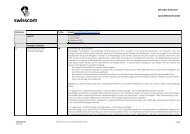Shareholders' Letter
Shareholders' Letter
Shareholders' Letter
Create successful ePaper yourself
Turn your PDF publications into a flip-book with our unique Google optimized e-Paper software.
Energy-efficient<br />
infrastructure<br />
tioning three electric vehicles in Lausanne, Berne and Zurich – locations where Swisscom generates<br />
an equivalent volume of solar power thanks to its own solar energy installations.<br />
In 2010, 101,600 (–7.6%) rail tickets for business trips and 13,000 (+4%) half-fare as well as 2,600<br />
(+3.5%) general transport passes were issued to employees.<br />
A separate CO 2 levy of 1.5 cents per air mile has been charged on international flights since 2007,<br />
and the money goes towards funding internal environmental projects in the field of mobility.<br />
In 2009 the internal cost allocation model was changed to the user-pays principle. As a result,<br />
internal car users must now pay the actual costs incurred and have an incentive to keep these to<br />
a minimum.<br />
Energy efficiency target agreement<br />
In 2010 Swisscom aimed to improve energy efficiency by 17% (compared to the reference year<br />
2002) and limit direct CO 2 emissions to a maximum of 28,109 tonnes. Details of Swisscom’s CO 2<br />
emissions are provided below and summarised in the table at the end of this section. By the end<br />
of 2010 Swisscom had increased energy efficiency by 17.5% versus 2002. This is in line with the<br />
targets agreed with the EnAW. The target is an average over the years between 2008 and 2012. In<br />
2010 Swisscom outperformed the new efficiency target (an increase of 20% by end-2015) by 2.7%,<br />
mainly thanks to one-off measures.<br />
Mistral project<br />
In 2010 Swisscom continued to pursue and implement the “Mistral” energy saving project. Mistral<br />
is a cooling technology that uses only fresh air all year round, thereby eliminating the need for<br />
conventional energy-intensive cooling systems with compressors and significantly enhancing<br />
energy efficiency. Moreover, Mistral requires no harmful refrigerants.<br />
Mistral was deployed in over 432 telephone exchanges by the end of 2010, an increase of 35%<br />
compared to the previous year. Fifteen more mobile base stations and five Swisscom Broadcast<br />
transmission stations were also converted to the new system in the course of the year. Fresh-air<br />
cooling also offers a genuine alternative for cooling data centres. At the end of 2010, accumulated<br />
savings in energy consumption versus former cooling methods amounted to 15.3 GWh. Once all<br />
installations in the public switched telephone network have been converted, Swisscom expects<br />
to save up to 45 million kilowatt hours of electricity per year versus conventional cooling methods.<br />
Inergie member<br />
Swisscom has been a member of the Inergie Association since July 2010. The aim of this association,<br />
whose members comprise Bernische Kraftwerke (BKW), IBM, Swiss Post, the municipality of<br />
Ittigen and Swisscom, is to develop new solutions to promote energy efficiency at the municipal<br />
level. To date, Inergie has launched a project for e-mobility as well as a smart metering/grid project<br />
in which Swisscom is involved.<br />
Climate<br />
Carbon footprint<br />
In terms of the direct consumption of fossil fuels, Swisscom’s carbon footprint has reduced slightly<br />
to 25,422 tonnes of CO 2 , of which vehicle fuel accounts for 49.7% and heating fuel 50.3%. Swisscom<br />
is therefore still on track with the targets agreed with the Energy Agency for Industry (EnAW). The<br />
electricity mix purchased in Switzerland as well as the district heating consumed by Swisscom are<br />
not generated from fossil fuels and are therefore free from CO 2 emissions. In its reporting,<br />
Swisscom applies the EnAW conversion factor for electricity production. While Swisscom does not<br />
conduct an estimation of other indirect CO 2 emissions at present (Scope 3 of the Greenhouse Gas<br />
Protocol Initiative), it continues to pursue ways of evaluating CO 2 emissions in suppliers’ logistical<br />
processes.<br />
Management Commentary 92 | 93<br />
Corporate Responsibility



